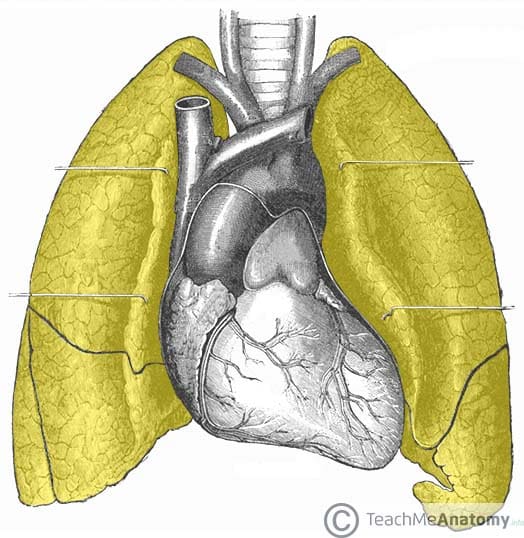The lungs are the organs of respiration. They are located in the thorax, either side of the mediastinum.
The function of the lungs is to oxygenate blood. They achieve this by bringing inspired air into close contact with oxygen-poor blood in the pulmonary capillaries.
In this article, we shall look at the anatomy of the lungs – their anatomical relations, neurovascular supply and clinical correlations.
Note: The anatomy of the trachea, bronchi, and bronchioles are covered in a separate article – see this page.
Premium Feature
3D Model
Anatomical Position and Relations
The lungs lie either side of the mediastinum, within the thoracic cavity. Each lung is surrounded by a pleural cavity, which is formed by the visceral and parietal pleura.
They are suspended from the mediastinum by the lung root – a collection of structures entering and leaving the lungs. The medial surfaces of both lungs lie in close proximity to several mediastinal structures:
| Left Lung | Right Lung |
|
|
Premium Feature
Dissection Images

Lung Structure
The lungs are roughly cone shaped, with an apex, base, three surfaces and three borders. The left lung is slightly smaller than the right – this is due to the presence of the heart.
Each lung consists of:
- Apex – The blunt superior end of the lung. It projects upwards, above the level of the 1st rib and into the floor of the neck.
- Base – The inferior surface of the lung, which sits on the diaphragm.
- Lobes (two or three) – These are separated by fissures within the lung.
- Surfaces (three) – These correspond to the area of the thorax that they face. They are named costal, mediastinal and diaphragmatic.
- Borders (three) – The edges of the lungs, named the anterior, inferior and posterior borders.
Lobes
The right and left lungs do not have an identical lobular structure.
The right lung has three lobes; superior, middle and inferior. The lobes are divided from each other by two fissures:
- Oblique fissure – Runs from the inferior border of the lung in a superoposterior direction, until it meets the posterior lung border.
- Horizontal fissure– Runs horizontally from the sternum, at the level of the 4th rib, to meet the oblique fissure.
The left lung contains superior and inferior lobes, which are separated by a similar oblique fissure.
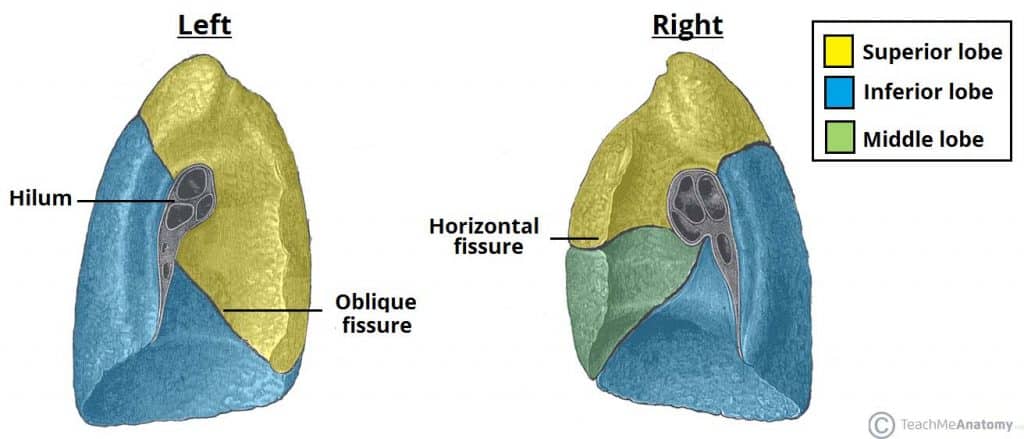
Fig 2
The lobes and fissures of the lungs. The oblique fissures are similar in both lungs
Surfaces
There are three lung surfaces, each corresponding to an area of the thorax.
The mediastinal surface of the lung faces the lateral aspect of the middle mediastinum. The lung hilum (where structures enter and leave the lung) is located on this surface.
The base of the lung is formed by the diaphragmatic surface. It rests on the dome of the diaphragm, and has a concave shape. This concavity is deeper in the right lung, due to the higher position of the right dome overlying the liver.
The costal surface is smooth and convex. It faces the internal surface of the chest wall. It is related to the costal pleura, which separates it from the ribs and innermost intercostal muscles.
Borders
The anterior border of the lung is formed by the convergence of the mediastinal and costal surfaces. On the left lung, the anterior border is marked by a deep notch, created by the apex of the heart. It is known as the cardiac notch.
The inferior border separates the base of the lung from the costal and mediastinal surfaces.
The posterior border is smooth and rounded (in contrast to the anterior and inferior borders, which are sharp). It is formed by the costal and mediastinal surfaces meeting posteriorly.
Root and Hilum
The lung root is a collection of structures that suspends the lung from the mediastinum. Each root contains a bronchus, pulmonary artery, two pulmonary veins, bronchial vessels, pulmonary plexus of nerves and lymphatic vessels.
All these structures enter or leave the lung via the hilum – a wedge shaped area on its mediastinal surface.
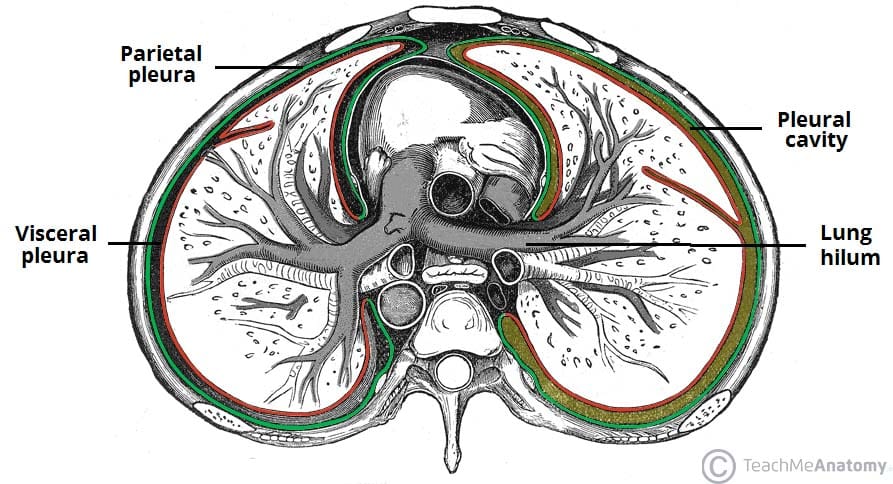
Fig 3
The parietal and viscera pleura, and the pleural cavity. Note how the two layers of pleura are continuous at the hilum of the lung.
Bronchial Tree
The bronchial tree is a series of passages that supplies air to the alveoli of the lungs. It begins with the trachea, which divides into a left and right bronchus.
Note: The right bronchus has a higher incidence of foreign body inhalation due to its wider shape and more vertical course.
Each bronchus enters the root of the lung, passing through the hilum. Inside the lung, they divide to form lobar bronchi – one supplying each lobe.
Each lobar bronchus then further divides into several tertiary segmental bronchi. Each segmental bronchus provides air to a bronchopulmonary segment – these are the functional units of the lungs.
The segmental bronchi give rise to many conducting bronchioles, which eventually lead into terminal bronchioles. Each terminal bronchiole gives off respiratory bronchioles, which feature thin walled outpocketings that extend from their lumens. These are the alveoli – the site of gaseous exchange.
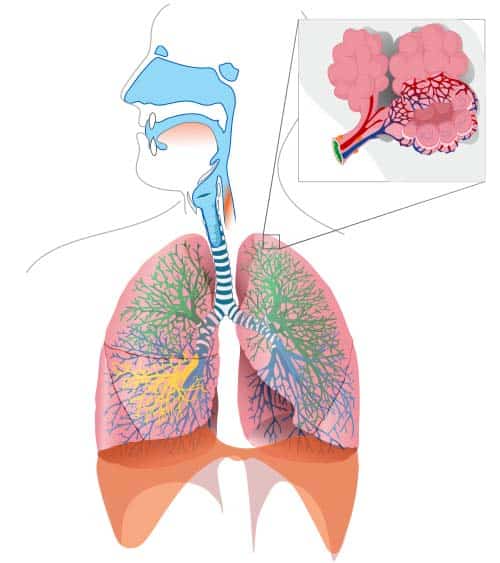
Fig 4
Overview of the tracheobronchial tree. Key: Green – upper lobe, yellow – middle lobe, blue – lower lobe
Vasculature
The lungs are supplied with deoxygenated blood by the paired pulmonary arteries. Once the blood has received oxygenation, it leaves the lungs via four pulmonary veins (two for each lung).
The bronchi, lung roots, visceral pleura and supporting lung tissues require an extra nutritive blood supply. This is delivered by the bronchial arteries, which arise from the descending aorta.
The bronchial veins provide venous drainage. The right bronchial vein drains into the azygos vein, whilst the left drains into the accessory hemiazygos vein.
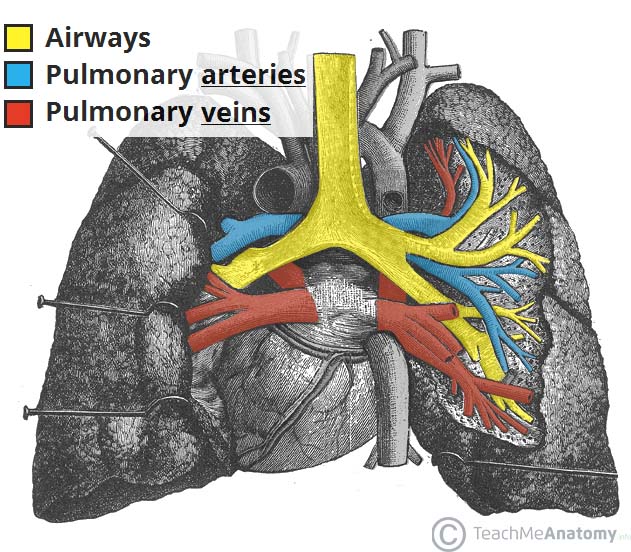
Fig 5
The vasculature of the lungs. Note that the arteries carry deoxygenated blood, and the veins carry oxygenated blood.
Nerve Supply
The nerves of the lungs are derived from the pulmonary plexuses. They feature sympathetic, parasympathetic and visceral afferent fibres:
- Parasympathetic – derived from the vagus nerve. They stimulate secretion from the bronchial glands, contraction of the bronchial smooth muscle, and vasodilation of the pulmonary vessels.
- Sympathetic – derived from the sympathetic trunks. They stimulate relaxation of the bronchial smooth muscle, and vasoconstriction of the pulmonary vessels.
- Visceral afferent – conduct pain impulses to the sensory ganglion of the vagus nerve.
Lymphatic Drainage
The lymphatic vessels of the lung arise from two lymphatic plexuses:
- Superficial (subpleural) – drains the lung parenchyma.
- Deep – drains the structures of the lung root.
Both these plexuses empty into the trachebronchial nodes – located around the bifurcation of the trachea and the main bronchi. From here, lymph passes into the right and left bronchomediastinal trunks.
Clinical Relevance
Pulmonary Embolism
A pulmonary embolism refers to the obstruction of a pulmonary artery by a substance that has travelled from elsewhere in the body. The most common emboli are:
- Thrombus – responsible for the majority of cases and usually arises in a distant vein.
- Fat – following a bone fracture or orthopaedic surgery.
- Air – following cannulation in the neck.
The effect of a pulmonary embolism is a reduction in lung perfusion. This results in decreased blood oxygenation, and the accumulation of blood in the right ventricle of the heart. Clinical features include dyspnoea, chest pain, cough, haemoptysis and tachypnoea. In clinical medicine, the Wells’ score is used to assess the probability of PE.
Definitive treatment involves anticoagulation and thrombolytic therapy. This reduces the size of the embolus, and prevents further clotting.
